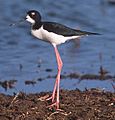Black-necked stilt facts for kids
Quick facts for kids Black-necked stilt |
|
|---|---|
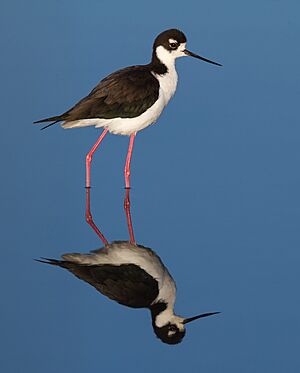 |
|
| An adult black-necked stilt near Corte Madera, California | |
| Scientific classification | |
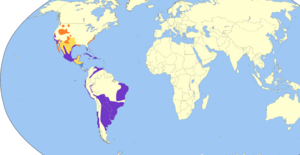 |
|
| Where black-necked stilts live (including the white-backed stilt in South America) | |
| Synonyms | |
|
Himantopus himantopus mexicanus |
The black-necked stilt (Himantopus mexicanus) is a tall, graceful shorebird. You can find it in wet areas and along coastlines in North and South America. These birds live from California and the western United States, all the way to Florida. They also live south through Central America and the Caribbean to Brazil, Peru, and the Galápagos Islands. There's even a special group, called the Hawaiian stilt, in Hawaii.
Stilts that live in the northern parts of their range often migrate south for winter. They travel from the southern United States to Mexico, and sometimes even to Costa Rica. Some experts think the black-necked stilt is actually a type of the common stilt.
Contents
What is a Black-necked Stilt?
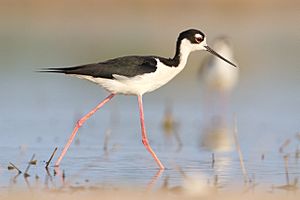
The black-necked stilt is a unique bird. It has very long pink legs and a long, thin black beak. Its body is mostly white, with black wings and a black back. The tail is white with some grey stripes. A black area goes from its back up its neck to its head. This black part covers its whole head like a cap, except for the area around its beak and a small white spot above its eye.
Male stilts have a slightly shiny, greenish look on their backs and wings. This is especially true during the breeding season. Females have a more brownish color in these areas. Otherwise, male and female stilts look very similar.
Baby stilts, called chicks, are light olive-brown. They have rows of black spots on their upper parts, where the adults are black. The rest of their body is a dull white.
How Big Are They?
- Length: About 13.8 to 15.3 inches (35 to 39 cm)
- Weight: Around 5.3 to 6.2 ounces (150 to 175 grams)
- Wingspan: About 28.1 to 29.7 inches (71 to 75 cm)
Where Do They Live?
Black-necked stilts live in many wet places. These include estuaries, lakes, salt ponds, and other wetlands. They usually live in low-lying areas. However, in Central America, they can be found in higher places, sometimes up to 8,200 feet (2,500 meters) high. They also live in areas that flood during certain seasons.
Since the 1960s, more stilts have been using salt evaporation ponds. These ponds are now a very important place for them to spend the winter. Many of these salt ponds are found in the southern San Francisco Bay area. In places like the Salton Sea, black-necked stilts live there all year.
You can find many stilts in the San Joaquin Valley in California. They often spend the winter there. They are also common in southern California from April to September. They breed along lake shores in northeastern California and southeastern Oregon. They also breed along the Colorado River.
Migration
Stilts that live in northern areas move south for the winter. This migration happens from July to September. They return to their breeding grounds between March and May. Usually, all the stilts from one breeding spot arrive together. They mate, lay eggs, and raise their young. Once the young can fly well (after about a month), the whole group leaves. They migrate in flocks of about 15 birds. Sometimes young birds gather in small groups, and other times families travel together. Stilts living in tropical areas also move around, but not over long distances.
What Do They Eat?
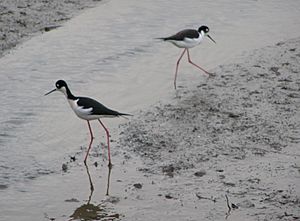
Black-necked stilts find their food by poking their long beaks into mudflats and lake shores. They also search in very shallow water near the shore. They mostly eat small water animals without backbones, like crustaceans (such as shrimp), insects (like worms and flies), and mollusks. Sometimes, they eat small fish, tadpoles, and very rarely, plant seeds.
What they eat most depends on what is available. Stilts living inland usually eat water insects and their young. Stilts living near the coast mostly eat other water animals without backbones. They like to find food in coastal estuaries, salt ponds, lake shores, and even flooded fields. When they need to rest, they choose dry, flat areas, lake shores, or islands surrounded by shallow water.
How Do They Raise Their Young?

Black-necked stilts build their nests on mudflats, dry lake edges, and levees. They need soft soil for their nests. In North America, they lay eggs from late April through August, with most activity in June. Stilts in tropical areas usually breed after the rainy season.
Their nests are usually less than 1 kilometer (0.6 miles) from where they find food. The stilt pairs work together to protect a large area around their nests. They patrol with their neighbors. Nests are usually about 65 feet (20 meters) apart. Sometimes they are as close as 7 feet (2 meters) or as far as 130 feet (40 meters) from another nest. Black-necked stilts are called "semicolonial" because their nests are rarely found alone. Colonies usually have dozens, or sometimes hundreds, of pairs.
Nests are often built close to the water's edge. This means they can be affected by rising water levels or tides. This is especially a problem in salt ponds where water levels can change quickly.
A female stilt usually lays 3 to 5 eggs, with 4 eggs being common. Both parents take turns sitting on the eggs for 22 to 26 days. The young chicks are very active soon after hatching. They can swim within two hours of being born! They can also run very fast at this young age. Even though they develop quickly, the chicks usually return to the nest to rest for another day or two. They learn to fly after about one month but still depend on their parents for a few more weeks. Stilts start having their own babies when they are 1 or 2 years old.
Status of the Black-necked Stilt
The number of black-necked stilts, especially in North America, has gone down a bit in the last century. This is mainly because their homes have been turned into human areas. Pollution also affects the birds and their food. However, overall, there are still many black-necked stilts, and they live across a large area. Because of this, the IUCN says the black-necked stilt is a species of "Least Concern." This means they are not currently in danger.
However, the Hawaiian stilt, which is sometimes considered a separate species, is very rare. There are fewer than 2,000 of them. It is thought that the small Indian mongoose, an animal brought to Hawaii to hunt rats, might have caused their numbers to drop.
Images for kids
-
The Hawaiian stilt is a type of black-necked stilt.





